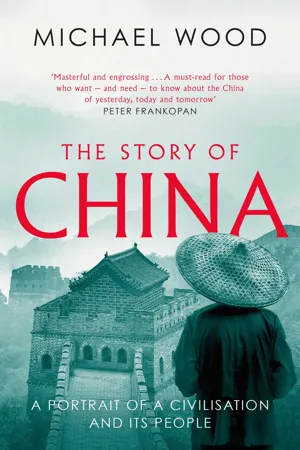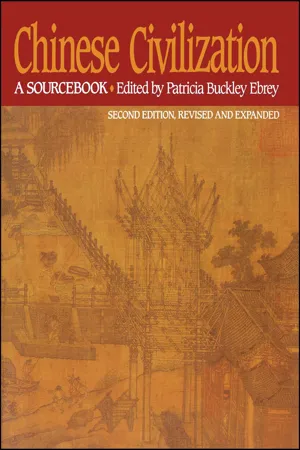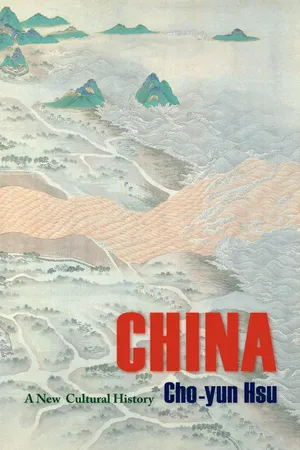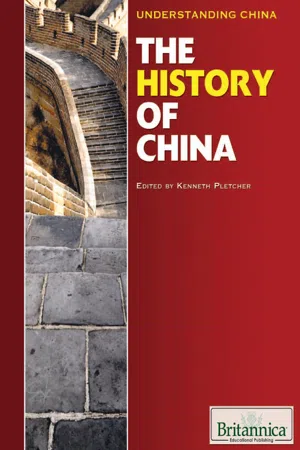History
Dynasty Yuan
The Yuan Dynasty was a Chinese dynasty established by Kublai Khan, the grandson of Genghis Khan, in 1271. It was the first foreign-led dynasty in China, with the Mongols ruling over the Chinese population. The Yuan Dynasty is known for its expansion of trade and cultural exchange, as well as its adoption of paper currency.
Written by Perlego with AI-assistance
Related key terms
Related key terms
1 of 4
Related key terms
1 of 3
9 Key excerpts on "Dynasty Yuan"
- eBook - ePub
- Paul Strathern(Author)
- 2020(Publication Date)
- Pegasus Books(Publisher)
5 The Yuan DynastyKublai Khan proclaimed the Yuan Dynasty in 1271, and set about completing his conquest of the Sung Dynasty of southern China, which would eventually unite north and south China for the first time since the Sung Dynasty had split off from the Jin Dynasty almost 150 years previously. China has traditionally flourished during periods when the north and south have been united. Unification would always prove difficult over such a vast region, although the people occupying this region are, and have been throughout history, for the most part homogenous Han Chinese.20Any consideration of Chinese history must be seen from the perspective of its long past, as well as the effect this may well have upon its future, and thus the future of world history. Effects and influences can take centuries to be understood. According to the story, when China’s twentieth-century communist ruler, Chairman Mao, was asked in the 1960s about the impact of the French Revolution, he is said to have replied, It is too early to tell.’Subsequent sources, hampered by a similar lack of hard facts, claim that this remark was really made by his prime minister, Zhou Enlai, who was said to have been referring to the Paris 1968 Student Revolution. The Chairman Mao version better illustrates the Chinese attitude towards historical effect. Even in Chinese communism, it is possible to detect age-old Buddhist influences which coloured attitudes back through the dynasties to the Yuan period and beyond.Unlike the previous empires we have discussed, which had their own origin myths, the Yuan Dynasty (1271–1368) was born out of a succession of previous dynasties. By the time of its birth, Dynastic China was already a mature culture, with a recognisable quasi-continuous history. As previously mentioned, Chinese Han civilisation evolved independently in the Yellow River basin of central China around 2,000 BC, i.e. a millennium or so after the Mesopotamian and Nilotic civilisations. Out of this Han civilisation, the legendary first Xia dynasty is said to have developed. Han rule gradually spread by ‘migration and assimilation’, which included the process of ‘sinicisation’, the adoption of the same diet, writing, language, lifestyle and general culture of the Han. - eBook - ePub
The Story of China
A portrait of a civilisation and its people
- Michael Wood(Author)
- 2020(Publication Date)
- Simon & Schuster UK(Publisher)
HE YUAN : CHINA UNDER THE MONGOL EMPIREIn the thirteenth century, China was conquered by the Mongols and became part of a world empire that extended from the Gobi to the Black Sea. To the Chinese literati and governing class, alien rule was a profound shock. This experience would lead to a deeply conservative and inward-looking reaction in the later fourteenth century, under the Ming dynasty. What then could have been a post-Song early modernity would turn out to be Ming despotism, shaped by the experience of conquest and foreign occupation. This would have long-term consequences, bequeathing a model of governance that would last down to today’s People’s Republic. However, though brief, the Mongol age would be another one of those interstitial periods between great epochs in Chinese history that was extraordinarily creative, laying markers for the future in governance, and in particular seeing a great opening up across the Eurasian world, with the first direct contacts between Western Europe and China.THE PRIMAL FORCE
In 1271 the Mongols announced the new dynasty in the Chinese language as the ‘Great Qian Yuan’. This ancient name meaning ‘Origin’ or ‘Primal Force’ enabled the founder, Kublai Khan, not only to show respect for China’s classical antiquity, but also to set the universalist pretensions of Chinese monarchy within even wider geographical limits. The Yuan ruled the Middle Kingdom through the Confucian officials of the former Southern Song governing class, along with many foreigners in their multi-racial, multi-lingual empire. The young Marco Polo, for example, seems to have served in the Yangzhou local government for two or three years, perhaps with the Italian merchant community in the city. If so, then he was just one of many outsiders making their fortune in the Mongol imperium. Yet the contacts also went the other way. The first Chinese person to go to Western Europe travelled from Beijing to Bordeaux in the 1280s, attempting to negotiate an alliance between the rulers of Christian Europe and the Mongols against the Muslim Caliphate. So the Mongol empire stirred up world history as never before. Whether in Plantagenet England or Yuan Dadu, it was a time of rich new possibilities. - eBook - ePub
Chinese Civilization
A Sourcebook, 2nd Ed
- Patricia Buckley Ebrey(Author)
- 2009(Publication Date)
- Free Press(Publisher)
PART V
THE MING DYNASTYAfter the Mongol empire broke apart and the Yuan dynasty collapsed, a Chinese dynasty was founded, the Ming (1368-1644). The early Ming was a period of recovery from some of the setbacks of Mongol rule, but many Yuan institutions were retained, since the forms and institutions of the Song could not be directly or fully restored. The Mongol capital at Beijing was made the Ming capital in 1421 and except for brief intervals has remained the capital of China until today. Economic revival led to a high level of commercial activity and handicraft production, but not to the innovative spirit of the early Song. Nevertheless, the Ming seems to have been one of the most prosperous periods of Chinese history. It was during these centuries that the great potential of south China came to be fully exploited. New crops such as cotton, maize, and sweet potato came to be widely cultivated, and industries such as porcelain and textiles flourished.The Ming is generally considered the first truly despotic or autocratic Chinese dynasty (if the Yuan is considered an alien dynasty). The problems of central control of a huge, complex empire appeared pressing to the early emperors, who were intent on assuring personal control of the machinery of the bureaucracy and finding ways to keep the officials in line. The Jurchen and Mongol innovation of provincial governments, consisting of branches of the central government, was developed further as a way to cope with the difficulty of direct central control of the whole empire. The censorate, imperial guard, and eunuchs were all used to keep the emperor informed of possible wrongdoing throughout the country. The arbitrary actions of the emperors undoubtedly demeaned the status of high officials and often jeopardized their welfare, but would have had less impact on villagers, whose affairs were still left pretty much to elders and local notables.Sources for the Ming are even more varied than for the Song. Particularly valuable are genealogies, charters, and other records of group activities which show the proclivity of peasants and townsmen to form corporate groups of various sorts, such as lineages, guilds, village associations, and secret societies. Such groups were probably common before the Ming, but they cannot be as well documented until then. The major reason for forming corporate groups seems to have been to gain protection from the casual mistreatment or exploitation of officials, large landowners, rich merchants, and other powerful people. Once one group of people had organized to protect their own interests, others would imitate them so as not to be left isolated. Indeed, by the Ming there is evidence that isolated individuals, without groups to support them, often lived precarious lives or had to put themselves under the protection of a landlord or employer who could take advantage of their weak position. - eBook - ePub
China
A Religious State
- Cho-yun Hsu, John Lagerwey, Timothy Baker, Jr., Michael Duke, Joseph Y. S. Cheng(Authors)
- 2012(Publication Date)
- Columbia University Press(Publisher)
And this period of history did not come to an end with the Mongol Yuan. In the traditional China-centered periodization, the Song dynasty is considered orthodox, and the regimes established by northern peoples are considered foreign conquest dynasties. We will, however, consider this situation, in which several nations fought against one another, as a sort of close mutual interaction in East Asia. Although one might also consider this another era of North-South dynasties, it seems more fitting to understand the changes taking place at this time as a process of gradual integration in the Asia Pacific region. The elements of this integration did not only include the Han Chinese agriculturalists and the nomadic northern nations struggling with one another on the East Asian land mass. They also included the nations on the shores of the Pacific Ocean, from Japan to Southeast Asia, that established relations of acceptance and rejection with the continental nations (or ethnic groups, zuqun). This process of regional integration lasted some five or six hundred years. In the later stages of change, the modern European, the Middle Eastern, and the Asia Pacific regions all experienced mutual interactions on an even greater scale and with even more wide-ranging consequences. Finally, today, in the world that we experience, nations have gradually moved in the direction of global integration. The Song Chinese living in Chinese-controlled areas also went through some complex and profound changes during this period. The structure of cities changed, and with that, the relationship between the cities and the countryside. The great clan (zongzu) organizations that had held sway since the end of the Han gradually devolved into smaller clans (jiazu) with much closer blood ties. The social status of these new clans was no longer as high as that of the former clan organizations - eBook - ePub
Yunnan-A Chinese Bridgehead to Asia
A Case Study of China's Political and Economic Relations with its Neighbours
- Tim Summers(Author)
- 2013(Publication Date)
- Chandos Publishing(Publisher)
An internecine feud brought the Nanzhao kingdom to an end, to be followed by the Dali kingdom, roughly coterminous with the Chinese Song dynasty. In contrast to the Tang court, the Song made clear that their territorial interests did not extend south of the Dadu River in southern Sichuan, creating an effective boundary between the Song and the Dali kingdom. Historical evidence suggests a degree of sophistication in local Nanzhao and Dali society during this period, for example the presence of mulberry-bark paper in both Yunnan and Bengal (Yang, ibid.: 52, 57), and trade in horses between Dali and the Song. Today’s Dali city retains architectural legacies of the Dali kingdom.Conquest by the Mongols in 1253 led to the incorporation of Dali’s territory into the Mongol empire, over 20 years before Kublai Khan took the Song capital in 1276. In 1274 the administrative province of Yunnan was formed (ibid.: 12), and thereafter the concept of ‘Yunnan’ as an imperial territorial and administrative entity became standard. The area covered by Yunnan at the time was much larger to the east than it is today, however, including some of what is now Guizhou, a province which was formed later, in 1413, during the Ming dynasty (ibid.: 121; see also Donaldson, 2011 : 28).Most histories describe the Mongol conquest using phrases such as ‘during the Yuan dynasty … Yunnan was annexed into China proper’ (Yang, 2009a : 111), or Yunnan ‘was not formally brought under direct Chinese control until the Mongol conquest of China in the thirteenth century’ (Solinger, 1977b : 6; see also Tapp, 2010 ). However, given the extensive geographical scope of the Mongol conquests well beyond the borders of what we now call China, it might be more useful to characterise this as Yunnan’s incorporation into Mongol Eurasia than think in more narrow terms of Yunnan’s incorporation into what in Chinese accounts of history has become represented as the ‘Chinese’ Yuan dynasty.2All of this history raises questions about how we characterise Yunnan’s identity during these centuries. Bin Yang (2009a : 14) sees Yunnan prior to the Yuan Mongol conquest as more ‘southeast Asian’ than ‘Chinese’. By the thirteenth century, though, he describes it as ‘politically subject to China, [while] economically … still more closely associated with the Indian Ocean region’ (ibid.: 206–7). He also talks about it as a ‘bridge connecting several civilizations’, and we should note that the Mongol conquest brought Muslim populations to Yunnan from central Asia, though Muslims may also have arrived earlier due to the maritime spread of Arabs to southeast Asia (Atwill, 2006 : 34; Lattimore, [1940] 1951 - eBook - ePub
- Britannica Educational Publishing, Kenneth Pletcher(Authors)
- 2010(Publication Date)
- Britannica Educational Publishing(Publisher)
Kublai Khan’s ascendancy in 1260 marked a definite change in Mongol government practice. Kublai moved the seat of Mongol government from Karakorum in Mongolia to Shangdu (“Upper Capital”), near present-day Dolun in Inner Mongolia. In 1267 the official capital was transferred to Zhongdu, where Kublai ordered the construction of a new walled city, replete with grand palaces and official quarters, that was renamed Dadu (“Great Capital”) before its completion. Under its Turkicized name, Cambaluc (Khan-baliq, “The Khan’s Town”), the capital became known throughout Asia and even Europe. But, true to nomad traditions, the Mongol court continued to move between these two residences—Shangdu in summer and Dadu in winter. With the establishment of Dadu as the seat of the central bureaucracy, Mongolia and Karakorum no longer remained the centre of the Mongol empire. Mongolia began to fall back to the status of a northern borderland, where a nomadic way of life continued and where Mongol grandees, dissatisfied with the growing Sinicization of the court, repeatedly engaged in rebellions.Kublai, who even prior to 1260 had surrounded himself with Chinese advisers such as the eminent Buddho-Daoist Liu Bingzhong and several former Jin scholar-officials, was still the nominal overlord of the other Mongol dominions (ulus ) in Asia. By then, however, his Chinese entourage had persuaded him to accept the role of a traditional Chinese emperor. A decisive step was taken in 1271 when the Chinese dominion was given a Chinese dynastic name—Da Yuan, the “Great Origin.” Before this the Chinese name for the Mongol state was Da Chao (“Great Dynasty”), introduced about 1217. It was a translation of the Mongol name Yeke Mongghol Ulus (“Great Mongol Nation”) adopted by Genghis Khan about 1206. The new name, however, was a departure from Chinese traditions. All earlier Chinese dynasties were named for ancient feudal states or geographic terms; even the Khitan and the Juchen had followed this tradition by naming their states Liao (for the Liao River in Manchuria) and Jin (“Gold,” for a river in Manchuria that had a Juchen name with that meaning). Yuan was the first nongeographic name of a Chinese dynasty since Wang Mang established the Xin dynasty (AD 9–25).Kublai Khan, grandson of Genghis Khan founded the Yuan (Mongol) dynasty in China . Hulton Archive/Getty ImagesDuring the 1260s the central bureaucracy and the local administration of the Chinese empire were remodeled on Chinese lines, with certain alterations introduced by the Jin state. The Central Secretariat remained the most important civilian authority, with specialized agencies such as the traditional six ministries of finance, war, officials, rites, punishments, and public works. The Shumiyuan (Military Council) was another institution inherited from previous dynasties. A Yushitai (Censorate) was originally created for remonstrations against the emperor and criticism of policies, but increasingly it became an instrument of the court itself and a tool to eliminate other members of the bureaucracy. In the main the territorial divisions followed Chinese models, but the degree of local independence was much smaller than it had been under the Song; the provincial administrations were actually branches of the Central Secretariat. The structures of the various provincial administrations throughout China were smaller replicas of the Central Secretariat. According to Chinese sources, in 1260–61 the lower echelons in the Central Secretariat were mostly Chinese; the high offices, however, even if they had traditional Chinese names, were reserved for non-Chinese. Surprisingly, Kublai Khan had few Mongols in high administrative positions; apparently suspicious of some of his tribal leaders, he preferred absolute foreigners. The military sphere was affected least by the attempts to achieve a synthesis between Chinese and native ways of life; there the Mongol aristocracy remained supreme. - eBook - ePub
China and the Mongols
History and Legend Under the Yüan and Ming
- Hok-Lam Chan(Author)
- 2018(Publication Date)
- Routledge(Publisher)
V THE DEMISE OF YÜAN RULE IN MONGOLIAN AND CHINESE LEGENDSINTRODUCTION
The collapse of the Yüan regime of Toghon-temür Qaghan (Shun-ti, [illegible text in source]. 1333–1370), precipitated in fall 1368 by the uprisings of the Chinese peasants in the Huai [illegible text in source] River valley aroused by ethnic animosity and the messianic propaganda of the White Lotus-Maitreya Buddhist sects, has been a subject of intense investigation by modem historians. Most of the sources were Chinese records, which unveil various causes of the downfall of the Mongol dynasty: factional strife in the Yüan court; regional warlordism; official corruption and fiscal mismanagement; political, social an4 economic inequalities; Chinese hatred of the alien rulers; outbursts of calamities and widespread destitution; and many others.1 The Mongols themselves did not leave a scrap of documents or writings about their demise, so historians must turn to Chinese sources for a reconstruction of the events, even though they reflect obvious prejudice against the Mongols.In modern folklore there exists, however, a closely related Mongolian and Chinese popular legend about the downfall of the Yüan regime as a result of uprisings of the Chinese population. Both the Chinese and Mongolian versions of this legend draw upon various historical sources and present them in a distorted and exaggerated form, and with imaginative, miraculous details, vividly portraying the popular notions of the turbulent era of Mongol rule in China and its ignominious termination. From their inception as a story of the depravity of the Mongol lamas and Chinese resistance against the oppressors, they grew into a fascinating, powerful legend transmitted in oral and written forms by various Mongol and Chinese agents: gossip-mongers, propagandists, storytellers, and popular writers, captivating a broad cross-section of their respective societies. Here I propose to examine the origins and evolution of these legends, separating fact from fiction, as a comparative study of an outstanding Mongolian and Chinese folk tradition through centuries of development. - eBook - ePub
- F. W. Mote(Author)
- 2003(Publication Date)
- Harvard University Press(Publisher)
yin preference system in access to official appointment, but also among the ordinary people. For example, several Chinese as well as alien dynasties tried to make military service hereditary, but none could prevent Chinese soldiers and sons of soldiers from fleeing that life. The Yuan household registration system restricted ordinary people in many ways in making their fundamental life choices; in so doing it denied individuals access to the small steps that might lead toward bettering themselves. It was thus contrary to the spirit of the achieving society, and it was resisted. The Mongol government maintained all of its social engineering regulations until the end but could not effectively enforce them. Anything so widely resisted becomes counterproductive.III . RELIGIONSIn the remaining sections of this chapter we turn from the Yuan dynasty’s formal structures for governing the Chinese people to the lives of people in society. Mongol government’s special character is particularly evident in its position on religions, seen here in the state’s attempts to manage and use religious activities for its own purposes. The attitude toward religions was largely benign, yet much of the story concerns the ways in which the religious groups misused or evaded the state’s attempts to manage them. The highly unusual religious situation throughout the century of Yuan rule, which had consequences for subsequent ages, is the subject of this section; here I discuss the special features of that situation at some length in the hope of casting light on the period’s social environment. Other features of Chinese life distinctive to this age are discussed in the following sections.The New Daoist Sects
The long history of Daoism began in the preimperial “golden age” of Chinese philosophy, the sixth through the third centuries B.C.E. That period produced Confucius and Mencius and the “Hundred Schools” of thought; it also is the period when the Daodejing attributed to the philosopher Laozi was written and when the great fourth-century B.C.E. philosopher Zhuangzi wrote the essential core of the book that bears his name. By Han times (second century B.C.E. to second century C.E. - eBook - ePub
- Stephen G. Haw(Author)
- 2006(Publication Date)
- Routledge(Publisher)
c.2000 BCE to 581 CEAfter the period of the ‘Five Emperors’, of whom the Yellow Emperor was the first, ancient Chinese texts record the earliest Chinese dynasty, the Xia. The actual existence of this dynasty remains unproven, as no contemporary written records of it have survived, but it is increasingly accepted that later accounts are likely to be reliable at least in their general purport. Dates at this period are very uncertain, but the Xia dynasty is usually accepted to have begun somewhere between about 2100 and 2000 BCE. Little is known about the extent of any Xia ‘state’, but it was probably quite small and is very unlikely to have included the Beijing area. Xia power was probably centred mainly in what is now the province of Henan, well to the south-west of Beijing. However, this does not mean that people living in the Beijing area during the Xia dynastic period did not share a similar level of culture with the Xia. The upper cultural level at the Xueshan site in Changping District has similar artefacts to those found at Erlitou in Henan, now usually considered to be a Xia site. Most importantly, objects made of copper and bronze form part of the cultural assemblage of upper Xueshan. This level probably dates to about 2000 to 1700 BCE.The Shang dynastic period
The Xia dynasty was overthrown and replaced by the Shang dynasty at some time around 1600 BCE. The Shang state was undoubtedly larger and more powerful than that of the Xia, but it remains doubtful whether the Beijing area ever came directly under Shang rule. With the Shang dynasty, however, Chinese history begins to become less obscure. Although no writings of Shang date were transmitted to the present day, archaeological investigations have recovered considerable quantities of Shang period inscriptions. These have confirmed not only that the dynasty definitely existed, but also that later accounts of it seem likely to be reasonably accurate. Most importantly, they have themselves provided considerable information about the dynasty, despite all the problems involved in reading and understanding them. These inscriptions are mainly on bone and tortoise or turtle shells, and were made as part of a process of divination regarding future events and actions. Some of these oracle-bone inscriptions mention a place called Yan, which seems to be a state, or at least some kind of political entity, probably with subordinate relations with the Shang state. Although the character is written differently in these very early inscriptions, there is good evidence to identify this Yan with the state called Yan that is known to have existed in the Beijing area during the Zhou dynasty, which succeeded the Shang. Several inscriptions say that ‘[people from] Yan came’, presumably to pay homage to the Shang king. There are also inscriptions that show that members of the ruling class of the Shang dynasty married women from Yan. One inscription refers to white horses from Yan, probably presented as tribute to the Shang king. The relative frequency of mentions of Yan in the inscriptions indicates that it was in close contact with the Shang state.
Index pages curate the most relevant extracts from our library of academic textbooks. They’ve been created using an in-house natural language model (NLM), each adding context and meaning to key research topics.
Explore more topic indexes
Explore more topic indexes
1 of 6
Explore more topic indexes
1 of 4








